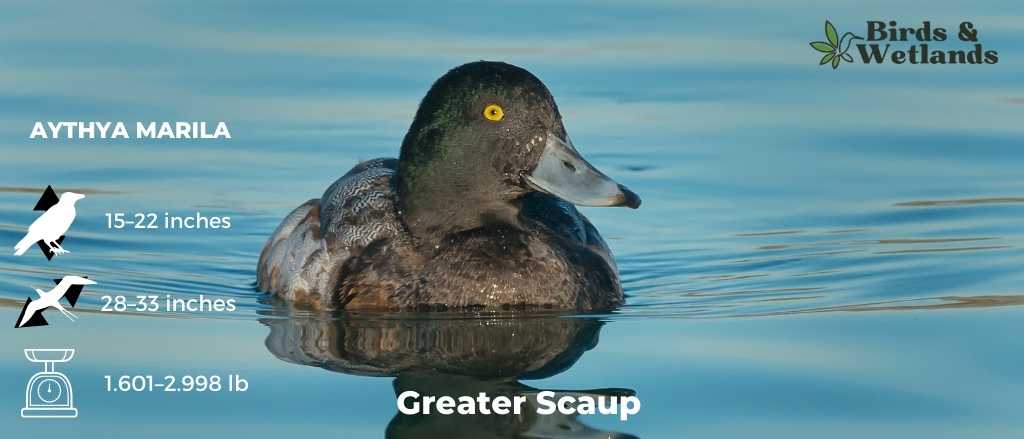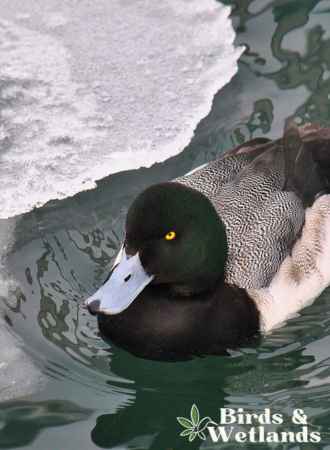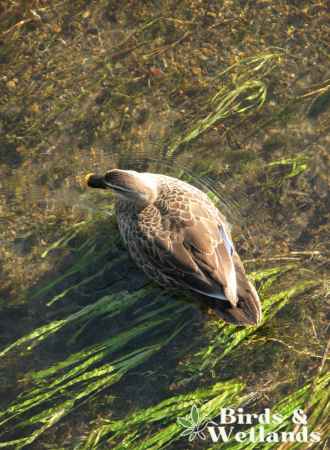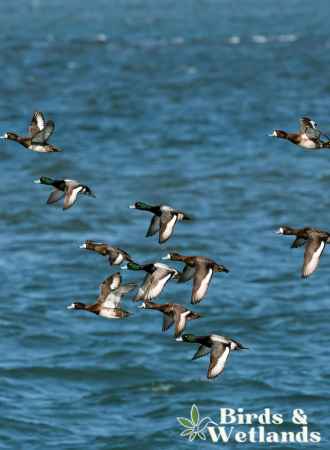
The greater scaup is a medium-sized diving duck found in many parts of the world, including North America, Europe, and Asia. It has a black head, neck and chest and a blue-gray back.
The greater scaup is known for its ability to dive deep underwater in search of food, such as aquatic plants and aquatic invertebrates.
The greater scaup is a common sight in many wetlands and aquatic habitats. It is often seen in large flocks near shorelines and shallow water.
Scientific Name: Aythya marila
Height: 39–56 cm (15–22 in)
Wingspan: 71–84 cm (28–33 in)
Weight: 726–1,360 g (1.601–2.998 lb)
Greater Scaup Description
The male greater scaup has an evenly rounded head and a golden yellow eye, contrasting with its glossy black or dark head and rear, and black breast. Its wings are predominantly white on the sides with gray on the back and lower flanks, and it has a broad bill that is pale grey-blue with a small black nail at the tip.
The legs and webbed feet of the scaup are dark slate-blue, completing its distinct physical appearance that is further accented by greenish or purplish iridescence visible on its head under ideal lighting.
The adult female greater scaup has a rounded head with smooth, dark brown body plumage. In comparison, the lesser scaup has an angular head.
On her face is a white band or white patch adjacent to her thick, greyish-blue bill which is slightly duller than the male, which tapers off to a point. She also has a white wing stripe.
Around her eyes are pale to whitish ear coverts, which may become quite visible in certain light or weather conditions. Her eyes appear yellow in certain lights but can also become somewhat grey.
Her legs and feet vary depending on the season, ranging from grey-green to dark slate blue. She has an impressive wingspan which she uses for both flying and swimming efficiently through the water.

Listen to Greater Scaup
Most of the time, the male is relatively silent while the female makes coarser calls than the female lesser scaup.
Greater Scaup Range
The greater scaup is an abundant waterfowl species with a circumpolar distribution, breeding within the Palearctic and Nearctic regions.
In North America, the greater scaup breeds from Newfoundland and Labrador to Alaska in the summertime. In Asia, its breeding habitat stretches from the Russian Far East to some parts of China.
The greater scaup populations extend into Central America during winter when they migrate south. This duck species can be seen along the coasts of North America from northern Canada south to Baja Peninsula, along both sides of the Great Lakes and the Gulf of Mexico.
Some birds spend winters in New Brunswick, Nova Scotia and Florida. Interestingly, the greater and lesser scaup are often found together.

Greater Scaup Habitat
The Greater Scaup can be found in various freshwater and coastal habitats, but they prefer specific areas. They can be found during breeding on inland lakes, pools, and bogs near the northern edges of boreal forests and the tundra.
During the winter, they typically migrate with the closely related lesser scaup to coastal waters and can be found in estuaries, bays, and lagoons along the Pacific and Atlantic coasts. Although some greater scaups visit inland freshwater lakes during this time of year, they prefer more open areas such as bays.
Some flocks of greater scaup also migrate further south during the winter than other duck species due to their reliance on coastal habitats for food sources, such as mollusks and crustaceans, which are abundant in these areas. But this duck is an uncommon winter resident in the southern parts of the US.

Greater Scaup Diet & Food Habits
The greater scaup is an excellent diver, capable of reaching depths of up to 6 meters (20 ft) and staying underwater for up to one minute. This remarkable ability allows them to feed on various food sources inaccessible to most other ducks. Like other diving ducks, the greater scaup is often seen swimming underwater to search for food on the sea floor.
Most of the diet of the greater scaup consists of mollusks, aquatic plants, aquatic insects, and small crustaceans during the summer months. They also consume seeds, leaves, stems, roots, sedges, pondweeds, musk grass and wild celery in freshwater ecosystems.
Greater scaups have a unique feeding behavior that involves diving below the water’s surface in search of prey. After they locate food items, they resurface and eat them on the surface or nearby vegetation.
The greater scaup breed of wild duck is highly adaptable regarding its food preferences, as most individuals will not hesitate to eat whatever is available at any given time. The greater scaup’s diet does vary with availability depending on season and habitat but generally remains consistent throughout its range.

Greater Scaup Nesting & Mating Habits
The greater scaup typically breeds in the northern limits of tundra and boreal forest areas, with most of the North American population found in Alaska. Most pairs form in early spring or late winter.
They begin breeding when they are two years old but may start nesting as early as one year.
Nesting usually occurs from May to early June, either in single pairs or loose groups spread out at a distance of about 1 meter apart.
Nests are usually formed near shallow water on islands, shorelines, or other floating vegetation and consist of depressions lined with grass and down hidden within dense vegetation.
During the nesting process, the female builds the nest while her mate defends against predators and intruders. The olive-buff eggs that are laid range from 5 to 11, with 8 being the most common number. The incubation period is between 24-28 days, depending on weather conditions and how well its parents defend it.
The male often leaves the female to molt on an isolated lake during incubation.
Once the eggs hatch, young ducks leave the nest within 24 hours. Young ducks follow their mother to the water and can find their own food immediately.

Greater Scaup Population & Conservation Status
The population of Greater Scaup has seen a sharp decline in recent years, estimated to be around 780,000 globally. Despite this number drop, the IUCN currently lists the species as “Least Concern”. This is largely due to their wide range and adaptability to diverse habitats, such as coastal marshes and lakes.
11% of the combined continental scaup population in North America is greater scaup.
However, hunting, habitat degradation, disturbance and the presence of contaminants and heavy metals in the water are primary factors contributing to this duck’s population decline.
In addition, warmer waters in Alaska have caused large portions of the population to relocate further south. Along the Atlantic coast alone, 70% of wintering scaups can now be found in urbanized areas.

Greater Scaup Hunting
Greater scaup hunting is a popular activity for many people in the United States. The U.S. Fish and Wildlife Service closely monitors the population of greater scaup and sets limits on how many individuals can be taken by hunters each year to maintain healthy numbers.
Hunters typically pursue greater scaup during the winter, when they are found in large flocks along coastal areas, rivers, large lakes, and coastal bays.
Key Points
- The greater scaup is a diving duck that dives to search for food.
- The head of the male has a greenish sheen in good lighting.
- The greater scaup’s breeding grounds are usually near water covered in dense vegetation.
- During the breeding season, females build a shallow depression lined with down and plant material on the ground.
- These ducks are often seen with lesser scaups at their wintering grounds.
- Pair formation starts in early spring or late winter.


